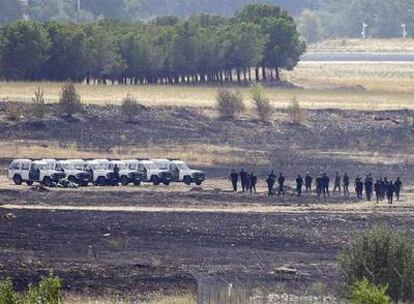Exact cause of Spanair crash remains a mystery, two years after Barajas tragedy
Experts say that relay link to alarm system may be fundamentally flawed
The cause behind the crash of Spanair Flight 5022 on August 20, 2008 is public knowledge: the pilots forgot to activate the flaps and slats that help the aircraft gain altitude. It has also been established that the alarm that should have alerted them to this oversight did not work. But 26 months after Spain's deadliest airline accident in a quarter of a century, it is still a mystery why this alarm system (known as TOWS or Take Off Warning System) malfunctioned. In other words, the ultimate cause of the death of 154 people still remains unknown.
Recent tests are now casting doubt on what, until now, the investigating judge had thought to be the reason for the TOWS failure. The problem had been blamed on the "multifunctional failure" of a relay (an electric device that activates a switch), and the mechanics who examined the aircraft before the tragedy were charged for failing to check this element properly.
There are few cases in commercial aviation history of accidents without human influence
There are few cases in commercial aviation history of accidents without human influence. And the accident report on the Barajas crash reports such an error: forgetting to activate the flaps and slats in an airplane that needed them more than ever because it was fully laden with passengers and luggage. Yet hardly anything is left exclusively to the crew in a modern aircraft, and the TOWS was there to make the captain and co-pilot (both of whom died in the crash) aware of the problem - or at least it should have.
Until now, Judge Juan Javier Pérez thought that the TOWS did not activate because of a failure of relay R-2-5. This belief was based on expert tests conducted soon after the accident in which technicians reported malfunctions in the relay, which was extracted from the wreckage in good enough condition for testing.
But that examination was not sufficiently thorough. In order to really analyze the relay device, it was necessary to take it apart. Spanair and the state agency in charge of aviation accidents had requested this move, but the judge originally rejected the request because it might destroy one of the key pieces of evidence in the case.
Yet on October 4 and 5 the judge changed his mind and agreed to open up the relay, convening all interested parties, and personally supervising the operation. Even Boeing, which manufactured the MD-82 aircraft, was invited to attend. The US firm refused, alleging that the conditions of the test contravened Annex XII of the world protocol on airline accident investigations.
It turned out that the relay device worked correctly and fed power to the TOWS as it should, apparently contradicting the faulty performance of earlier tests, which had led to the charges against the mechanic who allegedly neglected to adequately check this device. The same aircraft had suffered two very similar failures on the day prior to the fatal accident. Sources in the investigation now say it is possible that the relay works, and fails, intermittently.

Tu suscripción se está usando en otro dispositivo
¿Quieres añadir otro usuario a tu suscripción?
Si continúas leyendo en este dispositivo, no se podrá leer en el otro.
FlechaTu suscripción se está usando en otro dispositivo y solo puedes acceder a EL PAÍS desde un dispositivo a la vez.
Si quieres compartir tu cuenta, cambia tu suscripción a la modalidad Premium, así podrás añadir otro usuario. Cada uno accederá con su propia cuenta de email, lo que os permitirá personalizar vuestra experiencia en EL PAÍS.
¿Tienes una suscripción de empresa? Accede aquí para contratar más cuentas.
En el caso de no saber quién está usando tu cuenta, te recomendamos cambiar tu contraseña aquí.
Si decides continuar compartiendo tu cuenta, este mensaje se mostrará en tu dispositivo y en el de la otra persona que está usando tu cuenta de forma indefinida, afectando a tu experiencia de lectura. Puedes consultar aquí los términos y condiciones de la suscripción digital.
Últimas noticias
Pinochet’s victims grapple with José Antonio Kast’s rise in Chile
Reinhard Genzel, Nobel laureate in physics: ‘One-minute videos will never give you the truth’
How Japan is trying to avert ‘digital defeat’
The complicated life of Francesca Albanese: A rising figure in Italy but barred from every bank by Trump’s sanctions
Most viewed
- Pablo Escobar’s hippos: A serious environmental problem, 40 years on
- Why we lost the habit of sleeping in two segments and how that changed our sense of time
- Trump’s obsession with putting his name on everything is unprecedented in the United States
- Charles Dubouloz, mountaineering star, retires at 36 with a farewell tour inspired by Walter Bonatti
- The Florida Keys tourist paradise is besieged by immigration agents: ‘We’ve never seen anything like this’








































